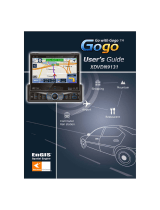7
Windshield Holder
The windshield holder is used to install your TomTom GO inside your car. To
learn how to attach the holder to your windshield, refer to the installation
poster.
Tips
• Make sure your windshield is clean and dry before you attach the holder.
• Place the holder so that it does not interfere with your view of the road.
• Attach the holder to an area of the windshield where the glass is flat.
Home Dock
The home dock is used for charging your TomTom GO when it is not in the car
and for connecting your GO to your computer.
When connected to your computer, you can use TomTom HOME with your
GO. For information about TomTom HOME, see Using TomTom HOME on
page 68.
Back Up Your TomTom GO
Regularly make a backup of the files on your TomTom GO using TomTom
HOME.
For more information about TomTom HOME, see Using TomTom HOME on
page 68.
Everyone Loves TomTom GO
Never leave your TomTom GO or accessories in view when you leave the car
or they may become an easy target for thieves.
Secure your TomTom GO
You can set a password for your TomTom GO which must be entered every
time you start your GO. You can set the password using TomTom HOME.
Take care of your TomTom GO
It is important to take care of your GO.
• Your GO is not designed for use in extreme temperatures and any such
exposure may cause permanent damage.
• Do not open the casing of your GO under any circumstances. Doing so may
be dangerous and will invalidate the warranty.
• Wipe or dry the screen of your GO using a soft cloth. Do not use any liquid
cleaners.
• Do not use the memory card in any device other than a TomTom device.
Improving reception
If your TomTom GO takes longer than 5 minutes to find your current position,
make sure that the device is in an open space away from tall objects such as
buildings or trees.
When you connect your TomTom GO to your computer, you can use
TomTom HOME to download information about where the GPS satellites are
going to be for the next 7 days.




















